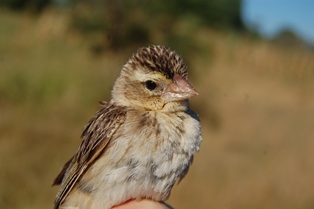Weaver news
| van de Ven TMFN, Mzilikazi N, McKechnie AE. 2013. Seasonal metabolic variation in two populations of an Afrotropical euplectid bird. Physiological and Biochemical Zoology 86:19-26. Abstract. Many birds exhibit seasonal phenotypic flexibility in basal metabolic rate (BMR) and summit metabolism (Msum), but very little information is available for species from subtropical latitudes or for conspecific populations from sites that vary in climate. We measured body mass (Mb), BMR, and Msum in summer and winter in two populations of the southern red bishop Euplectes orix, a passerine that is widespread in southern Africa. One population occurs at a comparatively warmer coastal site (mean daily minimum air temperature [Ta] in midwinter, 8.3 C) and the other at a colder inland site (mean daily minimum Ta in midwinter, -2.8 C). Bishops from both populations significantly increased Mb in winter. However, seasonal metabolic adjustments differed considerably between the populations. The inland population significantly increased BMR by approximately 58%, mass-specific BMR by approximately 31%, and Msum by approximately 15% in winter, although mass-specific Msum did not change significantly. In contrast, the coastal population showed no significant seasonal change in BMR and significant winter reductions in mass-specific BMR (~15%), Msum (~8%), and mass-specific Msum (~15%). The interpopulation differences in the magnitude and direction of seasonal mass-specific BMR changes are qualitatively consistent with global patterns, although the increase shown by the inland population is larger than expected. Our data reveal that avian seasonal metabolic adjustments can vary greatly within subtropical species depending on the climatic conditions experienced by the birds, and our findings reiterate the need to better understand metabolic flexibility in species that inhabit lower latitudes.
Photo (left): Southern Red Bishop female. Southern Red Bishops were studied during summer (January and February 2011) and winter (June and July 2011), at two sites in the Eastern Cape province of South Africa, namely, Aliwal North and Port Elizabeth. Only adult female birds were used for the study to avoid the potentially confounding effects of breeding season plumage in males. Females with obvious brood patches were excluded. Body mass varied significantly with season but not with study site. The authors conclude that tropical and subtropical species exhibit a degree of phenotypic flexibility in body mass and metabolic rate that is quantitatively comparable to that of species permanently resident in highly seasonal habitats at temperate and boreal latitudes. This paper is a result of Tanya van de Ven's MSc research - she became a ringer during her studies. See news item. Literature as featured in Weaver Watch news items |











